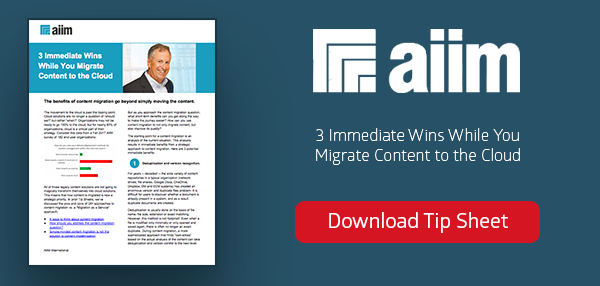9 steps to safely move your content to the cloud
by Sjoerd Alkema, on Oct 2, 2014 4:22:08 PM
The explosive growth of unstructured data we are all facing, is one of the reasons why many organizations nowadays consider cloud ECM solutions. However, having all enterprise content in the cloud is something we don’t see that often yet. There is a lot of caution regarding this subject, which of course makes sense, content holds a lot of value and risks. Content ending up in the wrong hands can cause great damage.
So how can you make that journey to the cloud safe, and how do you determine if you want all or just part of your content in the cloud? We have the solution and approach for this. Actually, that’s what we’ve been doing all along, does it matter if it is a cloud environment or an in house ECM, is is all about insights, classification, value and migration. So based on our experience, here's some free advise: a 9 step approach you can take using our Xillio software solutions.
1. Get insights in the total content landscape
Knowing what you have is the key to go to the cloud safely. It sounds obvious and it is, but getting total insights is not easy. Many clients I encounter have no true insights in what is stored on all their fileshares, digital collaboration tools, SharePoint sites etc.. When you know what you have you can set up a strategy, make a plan, know what you need to analyze more to go to the cloud.
2. Analyze the value of your content
Do you want to move everything to the cloud? Probably not. Start analyzing the value of your content to determine what you still need. This analysis might also determine high value content, that you think the risk is too large of to put in the cloud. For instance, you might want to keep your patents in your local patent system.
3. Dispose of what you do not need
Now you found what is of value you can dispose of what is not. Find duplicates, present them to the business and determine if they should be kept. Find old files no longer of value, Shortly, find the dark data. Do it in a controlled way, so you ar compliant and able to reproduce how you got to determine what was of no value.
4. Identify sensitive content and risks
Maybe the biggest issue struggling to go to the cloud is the fact there is no insight in sensitive content. With sensitive content I mean content that is a risk when it falls into the wrong hands. Like personally identifiable information, information about clients, business strategies, product concepts, and so on. This kind of information is key to any organization and you want it secure and safe. By analyzing where that type of information sits you can be sure about what your strategy.
5. Set up a migration approach and strategy
Now you know what you have, what has value and where sensitivities are, you can set up a migration strategy and approach. What do you want to migrate and why. These are discussions with business and stakeholders that determine how the project and cloud implementation is going to take place. I am not saying that some information discovered in the previous step cannot be stored in the cloud, it might be even more secure than your fileshares, but knowing what kind of information you are storing is important here.
6. Make sure of the right governance in your cloud environment
The insights in what content you are going to take to the cloud, are also input for the governance you will need to stay in control. Endless cloud storage seem interesting, but in fact creates a lot of unnecessary content and chaos that will in the end cost you. Governance means defined rules in what is stored, what metadata is used, what retention management is used, how long does it have value, what is the lifecycle of content, etc.
7. Classify and enrich
As part of moving to the cloud you want to bring as much value as possible to that new environment. Having determined what you have in the prior phases, you can now use this to add the right metadata and put the document in the right context in your new ECM to make the implementation a success and the use optimal.
8. Act and move
Execute the migration plan and move your content to the new environment. It is advised to do this in a phased way. Or even, if your organization is up for that, put the business is control and let them move their content themselves within the control of a migration manager.
9. Stay in control
You can migrate all the valuable content you want, but if you start using your new cloud environment without any governance and rules, it will not last long. This is why you must stay in control. Not only look at what you have at time of analysis, but keep doing this periodically. Make sure your cloud ECM is used within your governance, pollution stays away and you stay in control. Reuse the rules that determined the value at migration time.
-------------------------------------------------------------------------------------------
Read what the experts say
AIIM identified 3 immediate wins while you migrate content to the cloud. Download the tipsheet here.





-9.png?width=448&height=81&name=Untitled%20(400%20x%20200%20px)-9.png)